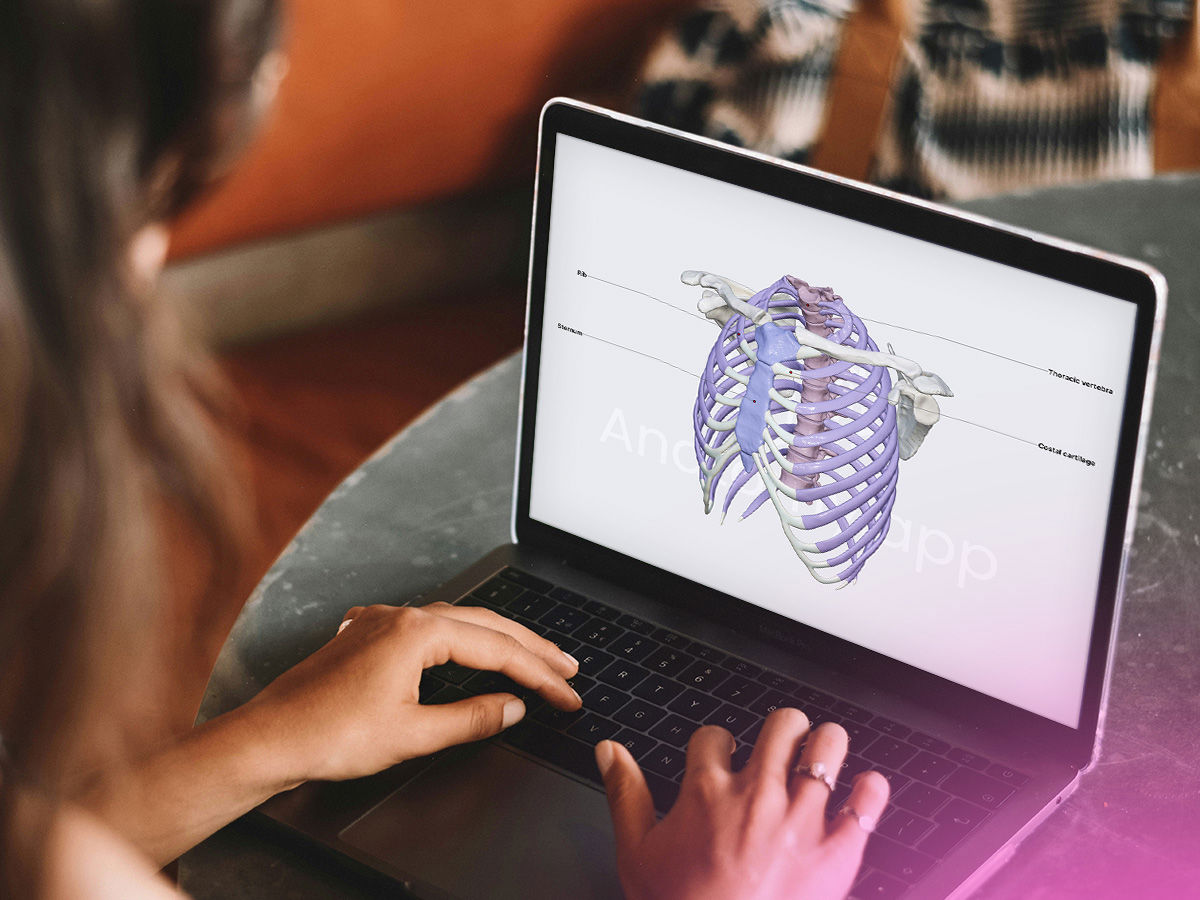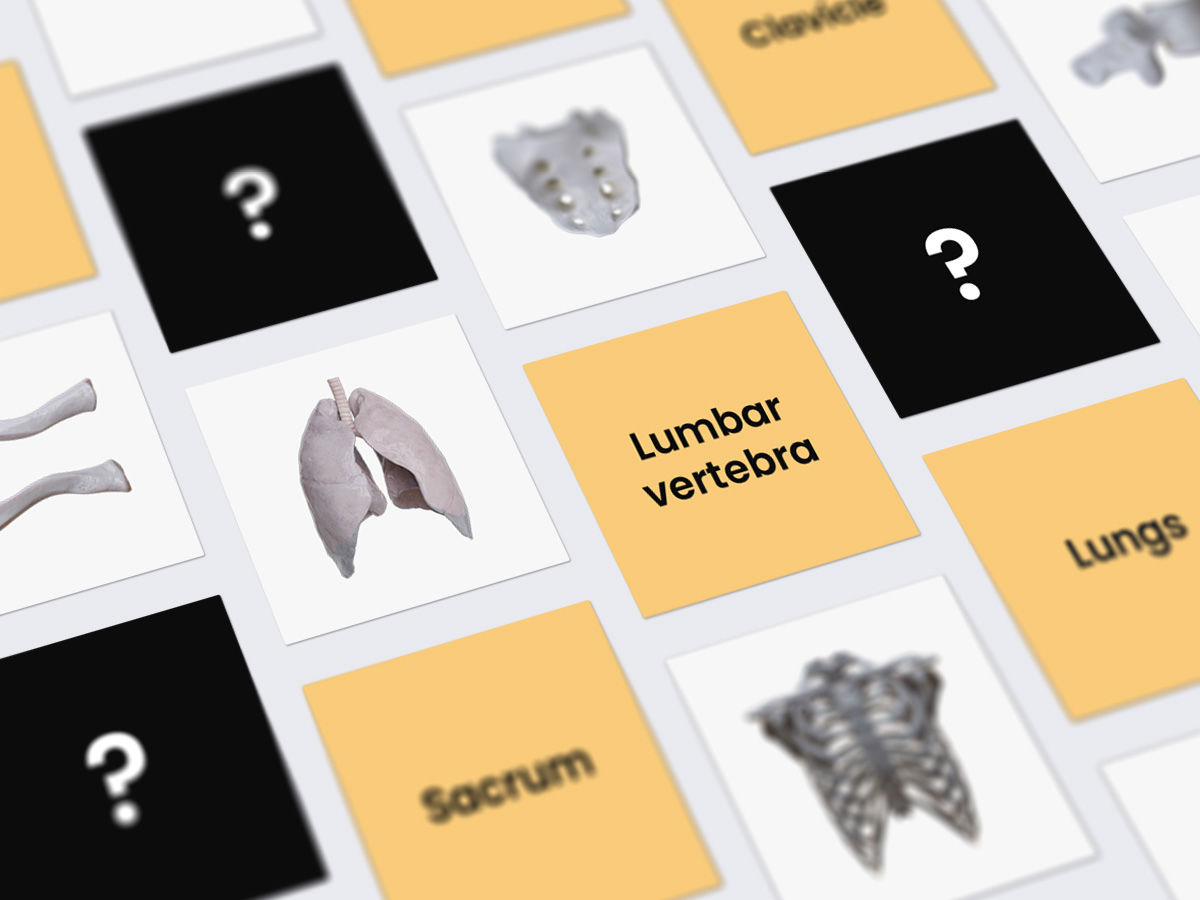How to Learn Anatomy Fast: 7 Techniques and Strategies for Success

The first steps into medical studies can be both exciting and challenging. But why is that? Anatomy, without a doubt! However, there is no need to blame this fascinating study subject. While the massive amount of new information, strange sounding terms and the complexity of all the anatomical structures can sometimes feel overwhelming, there are several techniques and strategies that can come in handy when embarking on the journey to learn anatomy and to learn it fast.
Learning anatomy is a fundamental and essential step for achieving further success in the medical field. In fact, anatomy is the cornerstone of medical studies, and it's like the air for medical students. Whether aspiring to become a cardiac surgeon or a neurologist, one simply cannot do so without first mastering anatomy.
In this article, we explore 7 techniques and strategies that can significantly help you learn anatomy faster and more effectively. From visual aids to practicing active learning techniques, these methods and strategies are tailored to help you achieve your goals and elevate your understanding, setting you on the path to success in learning anatomy fast. So, unlock the secrets and start mastering anatomy today!
1. Anatomical Terminology and Knowing the Basics
Embarking on studying anatomy may initially seem like delving into a new language, and indeed, it can be challenging - a massive amount of new terms that can't even be pronounced and so very little time. However, mastering basic anatomical terms is the key to learning and understanding anatomy faster.

Think of anatomical terminology as the foundation of a home - an essential framework without which understanding the human body becomes impossible. Anatomical terminology is indeed the foundation and the very beginning of anatomy studies to which further knowledge is built.
Let's say you travel to a new country, and no one speaks English there. Will you be able to understand them? Well, probably, but most likely no. Will it be more challenging to travel around that particular country? Yes, indeed, it will be!
So, the very first step one needs to take when diving into anatomy studies is to learn the basics. And there is something more about it - not only do you need to know the names of the anatomical terms, but you actually need to understand them. Try to understand the term by finding its meaning. For example, geni(o) goes for the chin or medial is applied when we speak about a structure that is located closer to the midline of the body - the medial corner of the eye is the one closest to the nose.
Begin the studies by understanding the basic concepts and anatomical terminology. Establish a strong foundation by getting to know the anatomical terms, body systems, and key structures before proceeding to more complex topics. So, the first and best thing to do is to find a good source that contains explanations of the basic anatomical terms, and then all you need to do is tighten your seatbelt and just be ready to take off.
2. Visual Aids
Learning without knowing is of no use. One of the most effective and fastest ways to learn anatomy is through various visual aids. Whether the visual materials include atlases, diagrams, 2D illustrations, 3D materials, or videos, the visual aids are real game-changers. And by real, we mean really huge game-changers. They help not only to memorize the structures but actually understand them (YES, we are saying this again because this is really important!), their position and relations in the body. Visual materials can significantly enhance your understanding of anatomy.
In fact, taking advantage of online resources and digital materials has become increasingly popular. It is the new black in anatomy. And there is no wonder! If you want to learn anatomy fast from anywhere and at any time, there is no better way than staying connected and doing it online. Hands-on experience with 3D anatomical models can provide invaluable insights into the human body and reinforce theoretical knowledge.

Additionally, finding radiographic images like X-rays and CT scans and practicing identifying anatomical structures on them can also be beneficial. Your future self will say thank you later. This will also help you develop a deeper and more practical understanding of the structures.
So, instead of passively reading those large sheets of paper, find a visual that explains the materials you are reading. There are plenty of resources available. Whether you prefer good old atlases or the latest 3D materials available on the web, use them as much as you can and whenever you are studying anatomy. Not only will you actually understand what you are reading about, but you and your anatomy professor will also be proud of your results in the anatomy course.
3. Repeat, Repeat, Repeat, and Repeat Again
If someone says that the more is not necessarily the better, it's obvious - they are not talking about anatomy. Repeat, repeat, and repeat again as much as you can. And now, read the previous sentence again.
Active repetition and learning are some of the most frequently recommended anatomy study strategies, and indeed, they are among the best, if not the best, techniques. Active recall is like the glue that holds all the puzzle pieces together and does not let them fall apart. The stronger the glue, the more impossible it is to break the puzzle and lose pieces.

Memory is like a muscle, and active repetition helps to strengthen it. So, start learning anatomy faster by exercising your memory today. Find some time each week to revisit previously learned materials and reinforce your understanding.
Elevate the game and create your own diagrams, draw illustrations, play games, rewrite your notes, and label structures when trying to remember information. These methods will indeed help to memorize all the anatomical structures faster, as active participation in the learning process not only retains the information but also helps strengthen your understanding.
Try to visualize the anatomical structures by looking at your own body. Examine your body and picture the structure and its location in your head. Another effective way to remember the information is to write it down. Also, you can say it aloud or combine both of these methods.
Moreover, you can create sticky notes with the key information and put them all around your home. Whenever you see one, read it out loud and visualize the structure that is mentioned on the note. Additionally, flashcards are also a very valuable tool for memorization.
And finally, have you ever heard of mnemonics? If you haven't, now is the right time to start using them. There are plenty of already existing mnemonics, but feel free to create your own, as you know what is best for you and your memory.
For instance, this mnemonic helps to remember the sequence of the twelve cranial nerves: Oh Oh Oh, To Touch And Feel Very Good Velvet, AH:
- Olfactory nerve (CN I) - first cranial nerve;
- Optic nerve (CN II) - second cranial nerve;
- Oculomotor nerve (CN III) - third cranial nerve;
- Trochlear nerve (CN IV) - fourth cranial nerve;
- Trigeminal nerve (CN V) - fifth cranial nerve;
- Abducens nerve (CN VI) - sixth cranial nerve;
- Facial nerve (CN VII) - seventh cranial nerve;
- Vestibulocochlear nerve (CN VIII) - eighth cranial nerve;
- Glossopharyngeal nerve (CN IX) - ninth cranial nerve;
- Vagus nerve (CN X) - tenth cranial nerve;
- Accessory nerve (CN XI) - eleventh cranial nerve;
- Hypoglossal nerve (CN XII) - twelfth cranial nerve.
Repeat anatomy over and over again like there is no tomorrow!
4. Quizzes and Testing Your Knowledge
Put your learning into practice by testing your knowledge through various quizzes. After you have studied a particular anatomical structure, challenge yourself and take quizzes. Quizzes are an effective tool as they also allow you to recall all learned information. Moreover, they help you to understand whether you have good knowledge about the study subject and what gaps you need to focus on while studying anatomy.
Quizzes are not only an excellent way to test yourself, but they are also very entertaining. Not to mention that they are a perfect way to learn anatomy faster, as they often include interactive illustrations and specific questions related to them. You can either create your own quizzes or use already existing materials. In both cases, it's a win-win for you.

We suggest you focus on the areas in which you are struggling and not doing so well when taking quizzes, as once you have done the quiz, it is impossible to forget the questions and answers. And it also means that you have probably learned something new. If you know a certain field of study very well, still test yourself but spend less time on it.
Turn your anatomy learning into an adventure and a game where every question is a chance to win the grand prize!
5. Study in Groups and Peer Teaching
Another great way to study anatomy faster is to study in groups with your peers. While it is not everyone's cup of tea, for many, joining forces with study buddies is the most effective way to learn anatomy faster, and it may also be beneficial to know that you are not the only one struggling with the subject. So, while it depends on your personality, the study techniques you prefer, and the materials you are learning, joining the study group might be a good decision.

Studying with others is not only an excellent way to discuss the structures, share insights and quiz each other, but it can also be fun and bring a lot of joy. Moreover, having someone to bounce off the ideas can help you retain information or the opposite - identify the areas that need extra attention. Some even say that studying together boosts their motivation. And for some, the best way to learn is to teach and explain things to people around them. Teaching others not only reinforces your own knowledge but also exposes you to different perspectives and approaches while learning anatomy.
There are several ways to make group studies happen, including online forums, social media groups, or face-to-face meetups. Participating in discussions, asking questions, and sharing resources can open doors to additional and new insights, supporting you in your learning journey. Moreover, having someone to seek help when encountering challenges or having questions can be a lifesaver. Clarifying doubts early on can prevent misconceptions and deepen your understanding.
So why not give it a shot? You never know if you never give it a try!
6. Find Out Your Learning Style and Combine Methods
Are you a visual or tactile learner? Maybe audio materials work best for you? Or perhaps you prefer reading out loud when studying? Understanding which learning style you call yours is the key to success in learning anatomy fast and faster.
Combine the methods that are the most beneficial to you, or stick to one if nothing else works. If you call digging through YouTube materials yours - perfect. Keep doing that! The key here is to figure out what learning style is yours so you can further develop your study habits based on your preferred style. That will not only make your studies more effective and efficient but also optimize your efforts and accelerate your learning.

Don't be afraid to experiment with different methods and techniques to find what truly clicks for you and makes your heart run faster. Sometimes, a combination of entirely different study techniques gives the best results. By staying open-minded and adaptable as you begin your journey in anatomy, you will uncover the perfect formula for mastering anatomy studies faster.
7. Learn to Love Anatomy
The easiest way to learn anatomy fast is to learn to love the subject. Anatomy isn't really learning only about the stomach parts or branches of the coronary arteries. It is also about connecting all structures and knowing which ones are clinically important.
Anatomy is the art of seeing a bigger picture. Try to connect every piece of information with another piece, and you will see the magic of how anatomy links all the information learned. Once you understand that, everything connects. That is also the breaking point when you will start to really appreciate your anatomy teachers and the importance of this subject.

The anatomy course might be only a couple of months long, but the knowledge you gain during it serves you a lifetime. Don't take it lightly! Find out the things that are unclear, do your research, take notes, and question everything. And never move further without understanding the topic properly. It can later turn out to be that missing key you are searching for success.
Additionally, anatomy is best and faster learned when you can apply it practically to real-life scenarios. Look for opportunities and consider volunteering, and that's when things probably will start to become more interesting, enjoyable, and understandable.
Don't forget to budget and manage your time by setting priorities when learning anatomy. Stay focused when studying. Do not share your valuable study time with TV series. Also, note that the actual time spent studying is often less important than how concentrated you are during that time. It's better to spend an hour a day studying but to have a full attention span than to study the whole day without barely paying attention to what you are reading about.
When thinking of anatomy, also think about why you are learning this subject. If you are learning anatomy to become a surgeon, you probably are not studying it just because you want to pass those exams. Do you really want to become that surgeon one day? Then, devote your primary effort to that. You are trying to achieve an important goal, and we are talking about human lives here.
So, learn to love anatomy and the whole world will join hands and say thank you later!
Wrapping up
In conclusion, while studying anatomy can be challenging and it takes a lot of effort and dedication, learning anatomy fast becomes achievable with the right techniques and strategies. By understanding the basics, using visual aids, engaging in active learning techniques, and choosing personalized study methods, learning anatomy from a nightmare becomes a dream. And remember, learning anatomy is not just only about memorization, but it is also about comprehension and understanding. When you start to understand things, learning anatomy becomes faster, more fun, and easier. Whether you are a medical student or an anatomy enthusiast, these techniques and strategies described in the blog will set you on the path to success. Learning anatomy has never been easier!